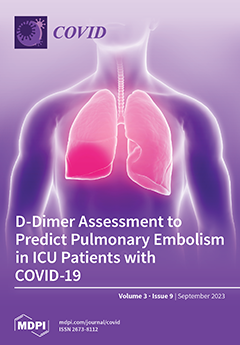Open AccessArticle
Association of ABO Blood Type with Infection and Severity of COVID-19 in Inpatient and Longitudinal Cohorts
by
Tiffany Eatz, Alejandro Max Antonio Mantero, Erin Williams, Charles J. Cash, Nathalie Perez, Zachary J. Cromar, Adiel Hernandez, Matthew Cordova, Neha Godbole, Anh Le, Rachel Lin, Sherry Luo, Anmol Patel, Yaa Abu, Suresh Pallikkuth and Savita Pahwa
Viewed by 1438
Abstract
The objectives of this study were to (1) investigate the association between human blood type and COVID-19 in both inpatient and longitudinal populations and (2) identify the association between blood type and severity of COVID-19 via presence of cellular biomarkers of severe infection
[...] Read more.
The objectives of this study were to (1) investigate the association between human blood type and COVID-19 in both inpatient and longitudinal populations and (2) identify the association between blood type and severity of COVID-19 via presence of cellular biomarkers of severe infection in hospitalized individuals at our institution in South Florida. This study consisted of (1) a single-center retrospective analysis of 669 out of 2741 COVID-19-positive, screened patients seen from 1 January 2020 until 31 March 2021 at the University of Miami Emergency Department (ED) who tested positive for COVID-19 and had a documented ABO blood type and (2) a longitudinal SARS-CoV-2 immunity study (“CITY”) at the University of Miami Miller School of Medicine, consisting of 185 survey participants. In an inpatient setting, blood type appeared to be associated with COVID-19 severity and mortality. Blood type O sustained less risk of COVID-19 mortality, and blood type O- demonstrated less risk of developing COVID-19 pneumonia. Inpatients with O- blood type exhibited less biomarkers of severe infection than did other blood types. In a longitudinal setting, there was no association found between blood type and SARS-CoV-2 infection.
Full article
►▼
Show Figures





